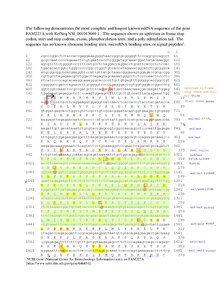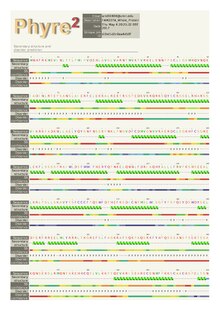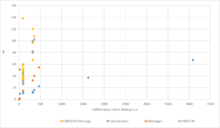| FAM227A | |||||||||||||||||||||||||||||||||||||||||||||||||||
|---|---|---|---|---|---|---|---|---|---|---|---|---|---|---|---|---|---|---|---|---|---|---|---|---|---|---|---|---|---|---|---|---|---|---|---|---|---|---|---|---|---|---|---|---|---|---|---|---|---|---|---|
| Identifiers | |||||||||||||||||||||||||||||||||||||||||||||||||||
| Aliases | FAM227A, family with sequence similarity 227 member A, FAM227a | ||||||||||||||||||||||||||||||||||||||||||||||||||
| External IDs | MGI: 1922979; HomoloGene: 123434; GeneCards: FAM227A; OMA:FAM227A - orthologs | ||||||||||||||||||||||||||||||||||||||||||||||||||
| |||||||||||||||||||||||||||||||||||||||||||||||||||
| |||||||||||||||||||||||||||||||||||||||||||||||||||
| |||||||||||||||||||||||||||||||||||||||||||||||||||
| |||||||||||||||||||||||||||||||||||||||||||||||||||
| Wikidata | |||||||||||||||||||||||||||||||||||||||||||||||||||
| |||||||||||||||||||||||||||||||||||||||||||||||||||
| This article may be too technical for most readers to understand. Please help improve it to make it understandable to non-experts, without removing the technical details. (May 2017) (Learn how and when to remove this message) |
FAM227A is a protein that in humans is encoded by FAM227A gene. Current studies have determined the location of this gene to be in the nuclear region of the cell. FAM227A is most highly expressed in the tissues of the fallopian tube, testis, and pituitary gland. FAM227A is present in species of mammals, birds and reptiles, and gene alignment sequences have shown that FAM227A is a rapidly evolving gene.
Gene
FAM227A is found on chromosome 22 at the location 22q13.1. It is flanked by the gene LOC105373031 on the left and CBY1 on the right. The gene is 78,510 base pairs long with 21 exons. There are currently no aliases for FAM227A.
mRNA
There are two isoforms of FAM227A. The first isoform, NM_001013647.1, has a shorter transcript but a longer isoform. It is 2,948 base pairs long, and includes the first 17 exons. The second isoform, NM_001291030.1, is 10,362 base pairs long. It starts translation at a different start codon than variant 1 by utilizing an alternate splice site. The 5’ region is relatively short but the 3’ region is very long.

Protein

The primary sequence for FAM227A is isoform 1 with accession number: NP_001013669.1. It is 570 amino acids long. There are 9 isoforms. The molecular weight is 66kD, and the isoelectric point is 9.6. Compared to other proteins in humans, FAM227A has less abundant glycine and more abundant hydrophobic amino acids and positively charges amino acids. The protein is predicted to be in the nuclear region of the cell. Three nuclear signals include HKKK at 129(pat 4), KKK at 130(pat4), and PKKTKIK at 410(pat7). An FWWh region, where h signifies hydrophobic, runs from amino acids 135-296 in Homo sapiens. Most eukaryotic proteins contain this sequence. The function of this region is still unknown. Motifs in FAM227A include KRK, SGK, and RRE.
Secondary Structure
The secondary structure is predicted to be made up of alpha helices mainly. but also beta pleated sheets.

Post-Translational Modification
Phosphorylation is the only predicted post-translational modification. There are three experimentally determined phosphorylation sites at Y343, S348, and S349.

Expression
FAM227A is experimentally determined to be highly expressed in the testis, epididymis, pituitary gland, and the fallopian tubes. This protein is not predicted to be ubiquitous as the rate of expression varies across tissue types.
Function
Currently, the function of FAM227A has not been characterized.
Interacting Proteins
Currently, there are no predicted proteins that interact with FAM227A
Subcellular Localization
FAM227A is predicted to be located in the nuclear region of the cell. This prediction is consistent across species.
| Nuclear | Mitochondrial | Cytoplasmic | Vacuolar | Extracellular | |
|---|---|---|---|---|---|
| Homo Sapiens | 43.5% | 17.4% | 17.4% | 8.7% | 4.3% |
| Nomascus leucogenys | 39.1% | 21.7% | 17.4% | 8.7% | 8.7% |
| Marmota marmota | 60.9% | N/A | 26.1% | 4.3% | N/A |
| Camelus bactrianus | 52.2% | 21.7% | 8.7% | 8.7% | 8.7% |
| Thamnophis sirtalis | 69.6% | 8.7% | 8.7% | N/A | N/A |
Homology
Paralogs: FAM227B
Orthologs: FAM227A is present mainly in mammals but also in species of reptiles and birds. The most distantly related ortholog is Xenopus tropicalis, the Western Clawed Frog. Based on the years of divergence for FAM227A, the gene evolved very rapidly.
| Order | Genus and Species | Common Name | Date of Divergence | Accession # | Sequence Identity to humans |
|---|---|---|---|---|---|
| Primates | Homo sapiens | Human | 0 | NP_001013669.1 | 100% |
| Primates | Nomascus leucogenys | Northern White-Cheeked Gibbon | 19.43 | XP_003264802.1 | 96% |
| Scandentia | Tupaia chinensis | Chinese Tree Shrew | 85 | XP_006155440.1 | 72% |
| Rodentia | Jaculus jaculus | Lesser Egyptian Jerboa | 88 | XP_012804178.1 | 61% |
| Carnivora | Ailuropoda melanoleuca | Giant Panda | 94 | XP_002914627.1 | 70% |
| Perissodactyla | Equus asinus | Donkey | 94 | XP_014706772.1 | 69% |
| Cetartiodactyla | Oncinus orca | Killer Whale | 94 | XP_012392035.1 | 63% |
| Soricomorpha | Condylura cristata | Star-Nosed Mole | 94 | XP_012590687.1 | 62% |
| Chiroptera | Eptesicus fuscus | Big Brown Bat | 94 | XP_008143135.1 | 61% |
| Cingulata | Dasypus novemcinctus | Nine Banded Armadillo | 102 | XP_004447922.1 | 70% |
| Sirenia | Trichechus manadtrus latirostris | West Indian Manatee | 102 | XP_004374098.1 | 59% |
| Tinamiformes | Tinamus guttatus | White-Throated Tinamou | 320 | XP_010218404.1 | 51% |
| Testudines | Pelodiscus sinensis | Chinese Softshell Turtle | 320 | XP_006119021.1 | 38% |
| Anura | Xenopus tropicalis | Western Clawed Frog | 353 | XP_002933807.2 | 34% |
Clinical Significance
In 2016, a study performed an association analysis on chromosome 22 at 31203 markers in order to determine if high blood pressure and smoking were correlated. Chromosome 22 was chosen based on the results of the data collected from three clinical visits at the Framingham Heart Study. In 2013, researchers investigated 3 clusters of SNP's thought to be linked to prostate cancer in Arab populations. The study found that the deletion region on chromosome 22q13, where FAM227A is located, can also be linked to breast and colorectal cancer in humans in addition to prostate cancer3. Another study suggests the location of FAM227A may be linked to a central regulator, SOX10, which is involved in the maturation of neural crest derivatives. Gene deletion of FAM227A was linked to lung abnormality, atrial septum defect, small size for gestational age, and sensorineural hearing loss in this study.
References
- ^ GRCh38: Ensembl release 89: ENSG00000184949 – Ensembl, May 2017
- ^ GRCm38: Ensembl release 89: ENSMUSG00000042564 – Ensembl, May 2017
- "Human PubMed Reference:". National Center for Biotechnology Information, U.S. National Library of Medicine.
- "Mouse PubMed Reference:". National Center for Biotechnology Information, U.S. National Library of Medicine.
- ^ "PSORT: Protein Subcellular Localization Prediction Tool". www.genscript.com. Retrieved 2017-04-27.
- ^ "BLAST: Basic Local Alignment Search Tool". blast.ncbi.nlm.nih.gov. Retrieved 2017-04-27.
- ^ "FAM227A family with sequence similarity 227 member A [Homo sapiens (human)] - Gene - NCBI". www.ncbi.nlm.nih.gov. Retrieved 2017-04-27.
- ^ "Homo sapiens family with sequence similarity 227 member A (FAM227A), t - Nucleotide - NCBI". www.ncbi.nlm.nih.gov. Retrieved 2017-04-27.
- "Homo sapiens family with sequence similarity 227 member A (FAM227A), t - Nucleotide - NCBI". www.ncbi.nlm.nih.gov. Retrieved 2017-05-05.
- Program by Dr. Luca Toldo, developed at http://www.embl-heidelberg.de. Changed by Bjoern Kindler to print also the lowest found net charge. Available at EMBL WWW Gateway to Isoelectric Point Service {{cite web |url=http://www.embl-heidelberg.de/cgi/pi-wrapper.pl |title=Archived copy |accessdate=2014-05-10 |url-status=dead |archiveurl=https://web.archive.org/web/20081026062821/http://www.embl-heidelberg.de/cgi/pi-wrapper.pl |archivedate=2008-10-26 }} Contact: Toldo@embl-heidelberg.de Bjoern.Kindler@embl-heidelberg.de
- Algorithm Citation: Brendel, V., Bucher, P., Nourbakhsh, I.R., Blaisdell, B.E. & Karlin, S. (1992) "Methods and algorithms for statistical analysis of protein sequences" Proc. Natl. Acad. Sci. U.S.A. 89, 2002-2006. Program Citation: Voker Brendel, Department of Mathematics, Stanford University, Stanford CA 94305, U.S.A., modified errors are due to modification.
- Protein structure prediction on the web: a case study using the Phyre server. Kelley LA and Sternberg MJE. Nature Protocols 4, 363-371 (2009)
- "Phyre 2 Results for FAM227A_Whole_Protein". www.sbg.bio.ic.ac.uk. Retrieved 2017-05-04.
- "BLAST: Basic Local Alignment Search Tool". blast.ncbi.nlm.nih.gov. Retrieved 2017-05-07.
- "Tissue expression of FAM227A - Summary - The Human Protein Atlas". www.proteinatlas.org. Retrieved 2017-04-27.
- Basson, J., Sung, Y. J., de las Fuentes, L., Schwander, K. L., Vazquez, A., & Rao, D. C. (2016). Three Approaches to Modeling Gene‐Environment Interactions in Longitudinal Family Data: Gene‐Smoking Interactions in Blood Pressure. Genetic epidemiology, 40(1), 73-80.
- Shan, J., Al-Rumaihi, K., Rabah, D., Al-Bozom, I., Kizhakayil, D., Farhat, K., ... & Khalak, H. G. (2013). Genome scan study of prostate cancer in Arabs: identification of three genomic regions with multiple prostate cancer susceptibility loci in Tunisians. Journal of translational medicine, 11(1), 121.
- Jelena, B., Christina, L., Eric, V., & Fabiola, Q. R. (2014). Phenotypic variability in Waardenburg syndrome resulting from a 22q12. 3‐q13. 1 microdeletion involving SOX10. American Journal of Medical Genetics Part A, 164(6), 1512-1519



